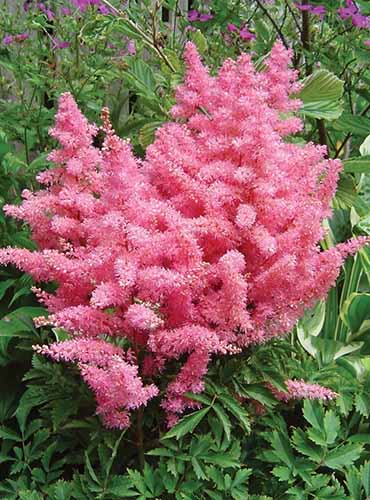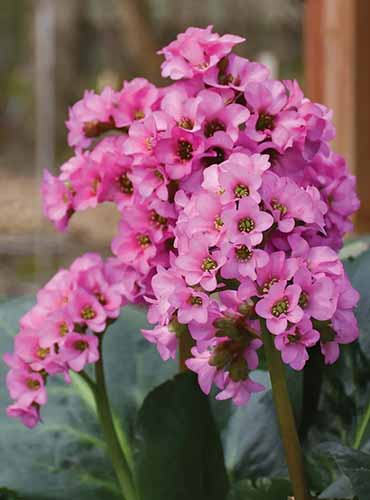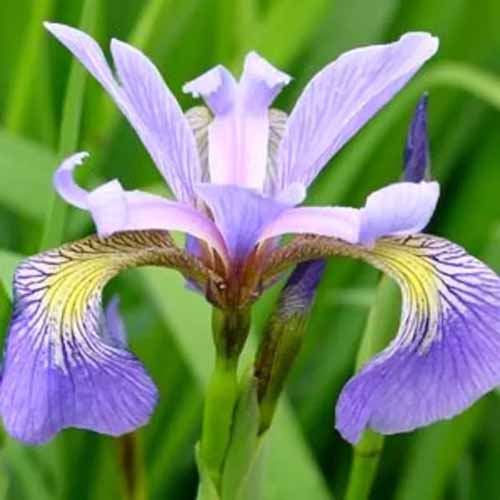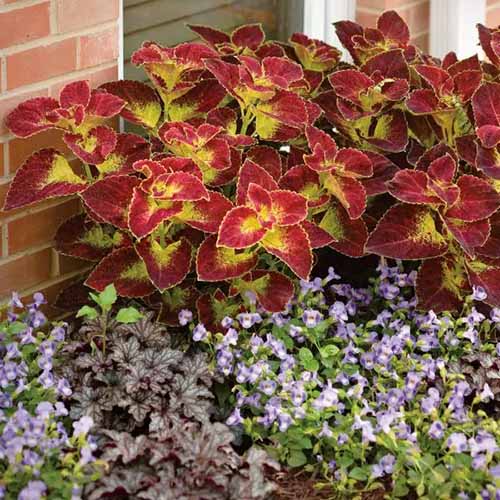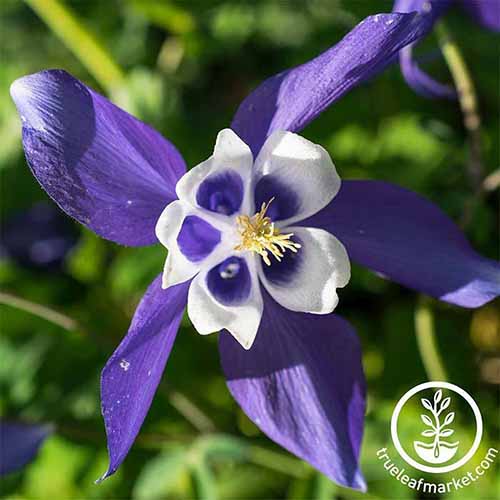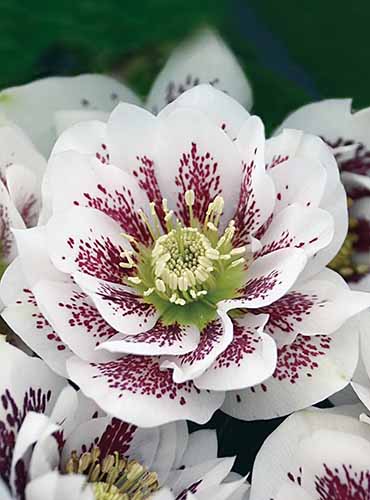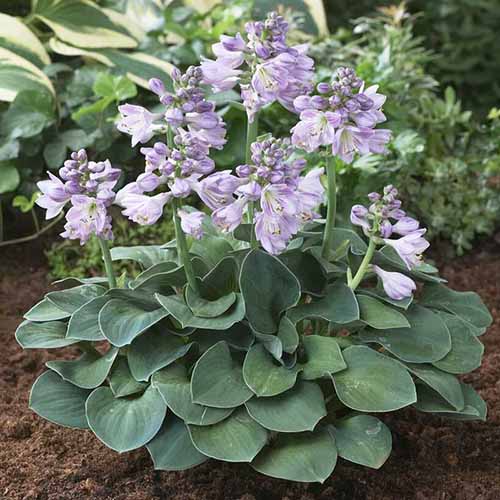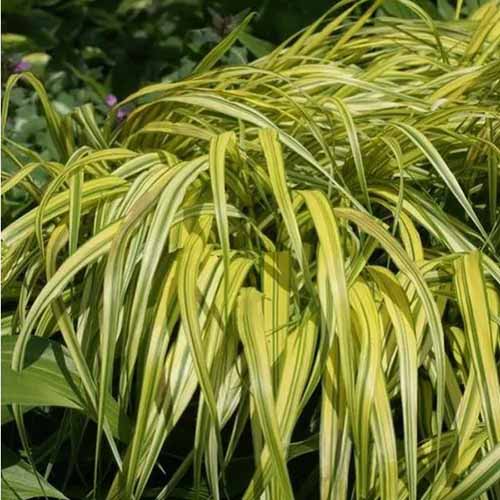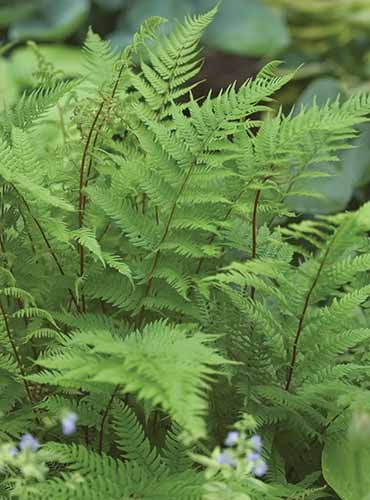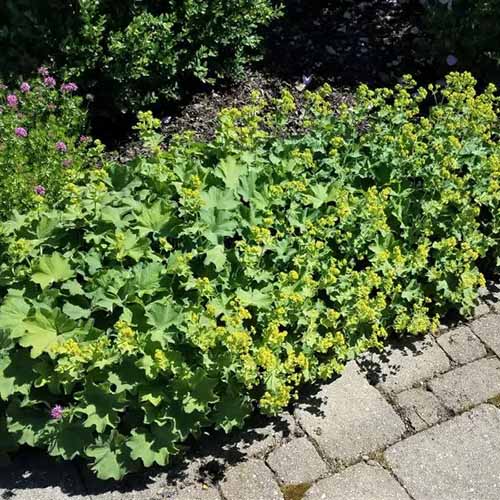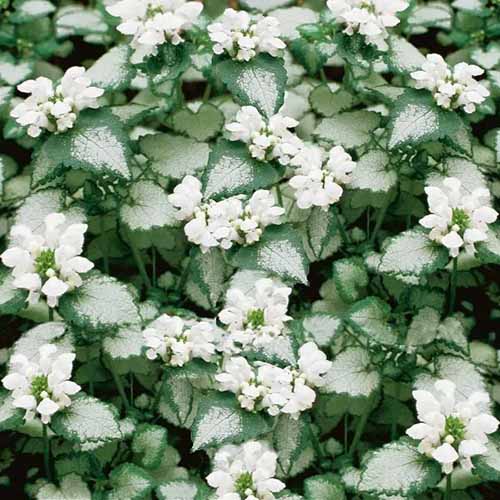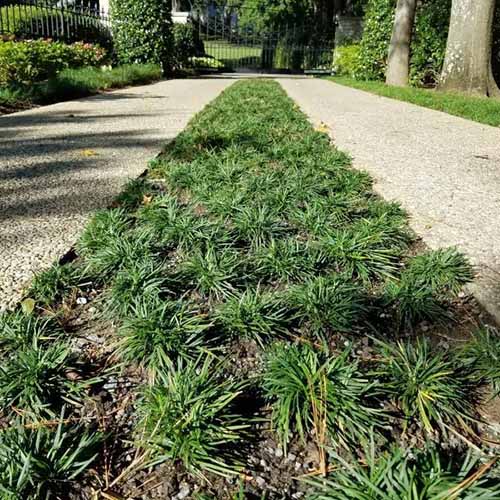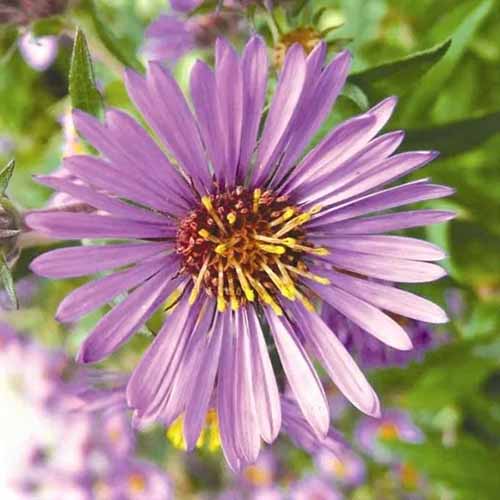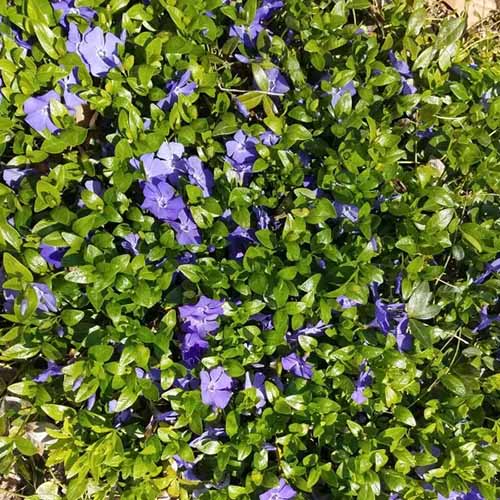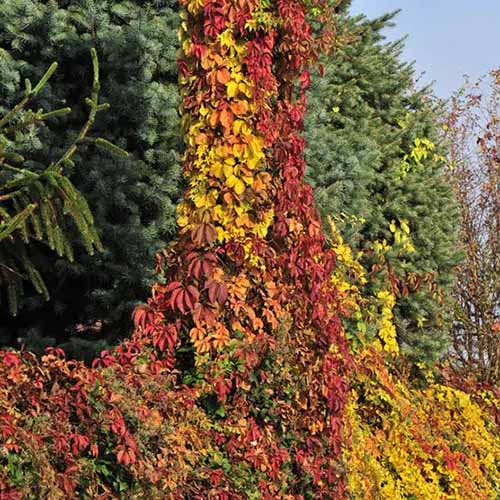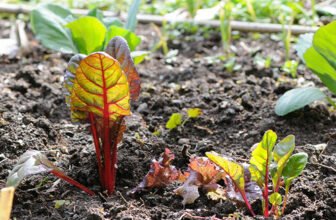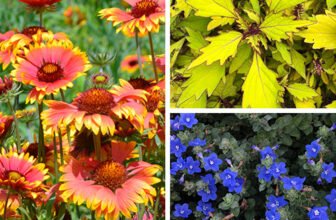
[ad_1]
Younique Pink™, (A. x ‘Verspink’) is a hybrid cross between A. arendsii and A. japonica with fluffy bubblegum pink blossoms and glossy gray-green foliage that turns bronze in the fall.
It grows well in Zones 4 to 9 in part to full shade. Mature heights are 16 to 20 inches.
Bare root Younique Pink™ astilbe plants are available from Burpee.
Learn more about how to grow astilbe in our guide.
2. Bergenia
Bergenia (Bergenia spp.) aka pigsqueak, is a flowering ground cover that’s hardy in Zones 2 to 9, depending on the variety.
It has clumps of glossy, dark green, leathery leaves that turn bronze in the fall in cooler regions.
In late winter to late spring, bright pink, purple, red, or white flowers appear in loose, branching clusters or panicles.
Plants prefer moist, well-draining soil and part to full shade. They mature to heights of 12 to 18 inches.
Bergenia ‘Miss Piggy’ is prized for its vibrant pink blooms and large leaves.
It’s best suited to Zones 4 to 8, and will grow to a mature height of 16 to 18 inches.
‘Miss Piggy’ bergenia plants are available from Burpee.
See our guide to growing bergenia for more information.
3. Blue Flag Iris
Blue flag iris, Iris versicolor, has upright stalks and terminal flowers consisting of bluish-purple “falls” or sepals accented by yellow.
Blooming in late spring to early summer, blue flag iris prefers wet soil and part shade to full sun locations in Zones 3 to 9.
This wetland species grows from rhizomes that are toxic and may cause skin irritation, so be sure to wear gloves when handling and keep children and pets away.
Mature heights are 24 to 30 inches.
Blue Flag iris is available from Nature Hills Nursery.
Learn more about how to grow irises in our guide.
4. Coleus
Coleus, Coleus scutellarioides, grows as a perennial in Zones 10 to 11 and as an annual elsewhere.
It is an ornamental foliage plant that thrives in part to full shade locations with moist, well-draining soil.
Key features of these plants are ruffled leaves and colors ranging from velvety, deep burgundy to bicolor hot pink and chartreuse combinations.
Tall spikes of tiny light blue blossoms appear late in the season and without deadheading, they run to seed and bring the growing season to a close.
ColorBlaze® ‘Dipt in Wine’ features leaves with wide, deep red margins and yellow centers. Mature heights are 12 to 18 inches tall.
ColorBlaze ‘Dipt in Wine’ Coleus
ColorBlaze® ‘Dipt in Wine’ is available from Nature Hills Nursery.
See our guide to growing coleus for more information.
5. Columbine
Columbine, (Aquilegia spp.) grows in Zones 3 to 9. This spring-to-summer bloomer has moderate water needs and prefers part shade to full sun locations.
It is known as an ephemeral because the delicate foliage withers and vanishes after a brief bloom period.
Native, introduced, and hybrid varieties are available in single and bicolor combinations with colors that include orange, pink, purple, red, white, and yellow.
The flowers have unique nectar-filled spurs that attract hummingbirds and bumble bees. Heights vary by type and range from six to 36 inches tall.
Rocky Mountain native, Aquilegia canadensis ‘Colorado Blue’ is prized for its generously proportioned violet-blue and white blossoms. Mature heights are 12 to 24 inches.
You can find ‘Colorado Blue’ seeds available from True Leaf Market in a variety of package sizes.
Check out our guide to growing columbine for more information.
6. Coral Bells
Coral bells (Heuchera spp.) grows in Zones 4 to 9 and prefers part shade to full sun placements.
In the warmest regions, it benefits from some afternoon shade. The growth habit is clumping with a basal mound of foliage ranging from chartreuse to purple.
Leafless inflorescences bear clusters of tiny, bell-shaped blossoms in pink or white hues from early summer to frost, depending upon the cultivar.
‘Paris’ boasts deep rose blossoms and richly lobed, silvery foliage with mint green veining, and reaches heights of seven to 10 inches.
You can find ‘Paris’ plants available from Burpee.
Our guide to growing coral bells has more information.
7. Daylily
There are about 15 species of summer-blooming daylilies (Hemerocallis spp.) and many cultivated hybrids.
They are rhizomatous plants that grow in Zones 3 to 9 in part shade locations, and reach average heights of 18 to 36 inches.
Funnel-shaped flowers in all colors except blow grow at the terminal ends of inflorescences that rise from clumps of sword-like foliage.
Fragrant ‘Ice Carnival’ sports slightly ruffled ivory funnels with soft yellow throats, and a mature height of 28 to 32 inches.
‘Ice Carnival’ daylily is available from Nature Hills Nursery.
See our guide to growing daylilies for details.
8. False Lamium
Lamiastrum galeobdolon, aka yellow archangel, looks like Lamium, or deadnettle, with its silvery-green foliage, but instead of pinkish-purple flowers, it sports bright yellow blooms.
False lamium is a fast-growing, creeping ground cover in the mint family that’s suited to Zones 4 to 9. Beware of its aggressive tendencies.
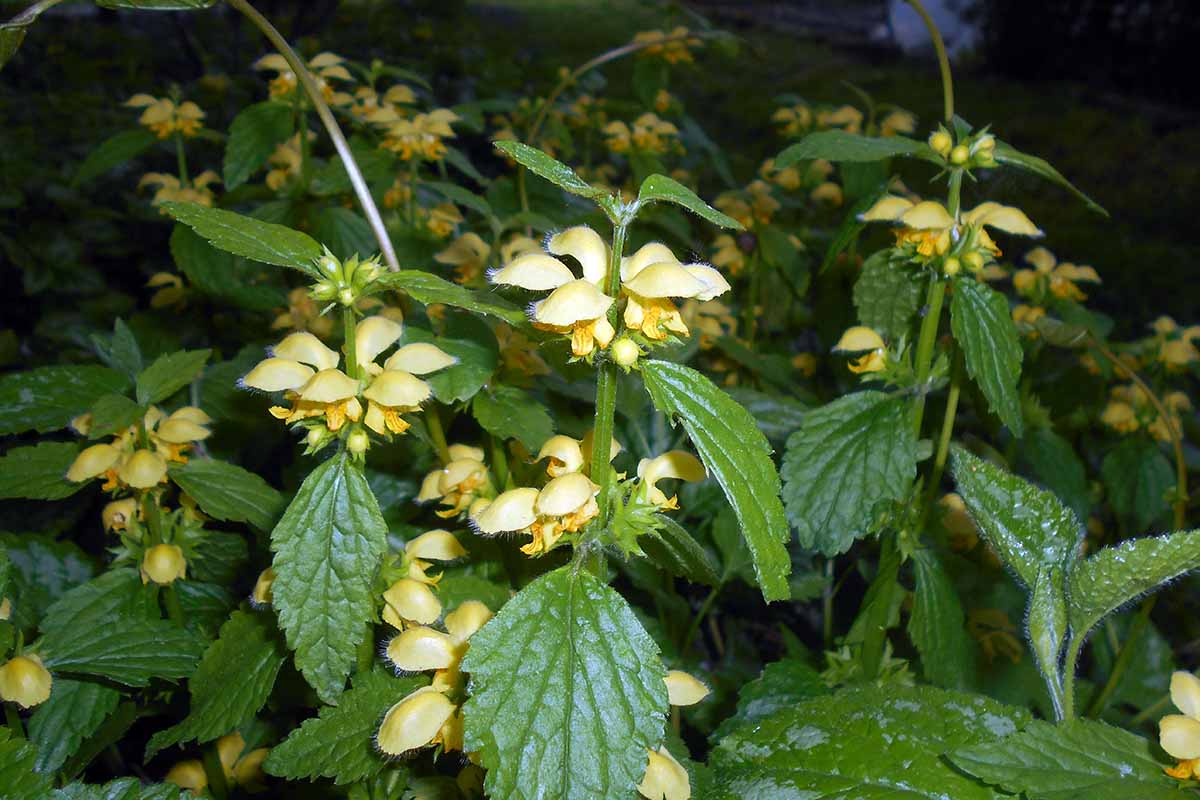

Plants grow in part sun to full shade with moist, well-draining soil. They mature to heights of six to 12 inches and provide a spring-to-fall display.
9. Hellebore
The hellebore (Helleborus spp.) is one of the earliest plants of the season, blooming in late winter or early spring.
The flowers are cuplike and nodding in green, pink, purple, red, white, and yellow hues. The foliage is dark green, deeply serrated, and leather-like.
Hellebores are suited to Zones 4 to 9, prefer moderate moisture, well-draining soil, and part to full shade. Mature heights are 12 to 24 inches.
Wedding Party® Confetti Cake Hellebore
Helleborus x orientalis Wedding Party® ‘Confetti Cake’ is a hybrid that displays generous double white blossoms with speckled burgundy throats and heights of 18 to 24 inches.
Wedding Party® ‘Confetti Cake’ plants are available from Burpee.
See our guide to growing hellebores for more information.
10. Hosta
Clump-forming hostas (Hosta spp.) are ornamental foliage plants for part to full shade locations in Zones 2 to 8. They bloom at various times from early summer to fall, depending on the variety.
The leaves are texturally rich with prominent veining and robust colors, including green, blue-green, gold, yellow, cream, variegated, and white.
Bell-like blossoms are arranged along upright inflorescences and may be lavender, pink, purple, red, white, or yellow.
‘Blue Mouse Ears’ has blue-gray-green heart-shaped leaves and lavender blooms. It thrives in deep shade and reaches mature heights of 15 to 20 inches.
You can find ‘Blue Mouse Ears’ rhizomes available from Eden Brothers.
Our guide to growing hostas has cultivation details.
11. Japanese Forest Grass
Ornamental Japanese forest grass, Hakonechloa macra, aka Hakone grass, grows in Zones 5 to 9 in moist, well-draining soil.
It prefers part shade but has a high tolerance for dark conditions, although variegated types have less distinctive coloring in very low light.
Growing from rhizomes, it has bamboo-like leaves and a mounding growth habit for a fountain-like presentation.
Bloom time is summer, but the greenish-yellow flowers are nondescript and often obscured by the foliage. Mature heights are generally 12 to 18 inches tall.
‘All Gold’ Japanese Forest Grass
‘All Gold’ brightens up the garden with variegated gold and green foliage, and reaches heights of 18 to 24 inches.
‘All Gold’ Japanese forest grass is available from Nature Hills Nursery in #1 containers.
12. Japanese Spurge
Japanese spurge (Pachysandra terminalis) is an evergreen ground cover for Zones 4 to 8 that thrives in part to full shade locations with moderate moisture and well-draining soil.
The foliage is dark green, and tiny spikes of white blossoms appear in the spring, on three- to four-inch tall plants.
Pachysandra plants spread via runners and this species is known to have aggressive tendencies, so check with your local agricultural extension office before planting it in your locale.
The species is classified as invasive in Pennsylvania, Virginia, and Washington, D.C.
Pachysandra is available from Perennial Farm Marketplace™ in four-inch pots via Amazon.
13. Lady Fern
Lady fern, Athyrium filix-femina, is a light green fern for Zones 4 to 9 that averages one to three feet tall in gardens, but wild specimens are generally between two and five feet.
It grows from rhizomes and is suited to moist, well-draining soil, and part to full shade.
The species has a clumping, upright growth habit and lance-shaped fronds that unfurl in the spring and die back with the first frost.
The ‘Lady in Red’ cultivar has red stems and the classic lacy fronds of the species, topping out at two to three feet. This cultivar is exceptionally cold hardy, and best suited to Zones 2 to 8.
‘Lady in Red’ lady fern is available from Burpee.
14. Lady’s Mantle
Lady’s mantle, Alchemilla mollis, is a clumping species for Zones 3 to 7 with a basal mound of scalloped, gray-green leaves and airy clusters of star-shaped chartreuse blossoms that seem to hover above the foliage.
Bloom time is early summer, but deadheading spent blooms may result in a second, less showy display late in the season.
Plants mature to heights of 12 to 24 inches, and while their preference is part shade to full sun, they tolerate full shade. Moist, well-draining conditions are best.
Lady’s mantle is available from Nature Hills Nursery in #1 containers.
See our guide to growing lady’s mantle for details.
15. Lamium
Lamium, Lamium maculatum, aka spotted deadnettle, is a ground cover for Zones 3 to 8, not to be mistaken for stinging nettle or false lamium.
The foliage is variegated green and silver and grows in a clumping, creeping fashion.
Flowers have petals resembling upper and lower lips in shades of pink, purple, or white. They bloom from late spring to early summer and occasionally through to fall.
Plants grow to low-profile heights of six to nine inches and prefer moist, well-draining conditions in part to full shade.
The variegated foliage does best with some sun to support the color variation.
‘White Nancy’ has silver foliage with green margins and white blossoms.
Plants in #1 containers are available from Nature Hills Nursery.
16. Lily Turf
Lily turf (Liriope muscari) is suited to cultivation in Zones 5 to 10.
It’s a clumping ground cover with a fountain-like display of strappy, grass-like foliage and spikes of white or purple flowers.
Bloom time is late summer to fall and mature heights are 12 to 18 inches.
The species thrives in part shade to full sun but can tolerate deep shade. Under low light conditions, it grows more slowly and has longer leaves.
Cultivated varieties may be even more tolerant of low light. New plants benefit from even moisture while they are becoming established. Once mature, they are drought tolerant and seldom need supplemental watering.
‘Royal Purple’ lives up to its name with bright purple blossom spikes, and reaches mature heights of 12 to 15 inches.
You can find ‘Royal Purple’ lily turf in #1 containers available from Nature Hills Nursery.
17. Mondo Grass
Mondo grass (Ophiopogon spp.) aka monkey grass, is an ornamental grass suited to Zones 5 to 11 – depending on the variety. It prefers full shade to part sun and moist, well-draining conditions.
Plants have an upright to arching form, clumping growth habit, and dark green or black, grasslike foliage, with heights of eight to 16 inches.
Ophiopogon japonicus ‘Nana’ is hardy in Zones 6 to 11. It is a petite cultivar that tops out between four and six inches tall, and has a preference for part to full shade.
The foliage is green with prominent racemes of showy white summer blooms and metallic blue fall berries.
‘Nana’ dwarf mondo grass is available from Nature Hills Nursery in quart-sized containers.
Our guide to growing mondo grass has more information.
18. New England Aster
The New England Aster (Aster novae‐angliae) is an herbaceous wildflower for Zones 3 to 8 that prefers part shade to full sun, moderate moisture, and well-draining soil.
The daisy-like flowers are available in pink, purple, violet-blue, or white, depending on the cultivar.
Mature heights are three to five feet tall, and bloom time is from late summer to first frost.
You can find lavender-blue New England asters available from Nature Hills Nursery.
Learn more about growing New England asters in our guide.
19. Periwinkle
Periwinkle (Vinca minor) aka creeping myrtle, is an evergreen ground cover for Zones 4 to 9 with trailing stems of dark green leaves and lavender-blue late spring to early summer flowers that resemble those of phlox.
Mature heights are three to six inches. Plants tolerate deep shade and rocky soil.
Periwinkle plants in quart-sized containers are available from Nature Hills Nursery.
20. Solomon’s Seal
Solomon’s seal, Polygonatum spp., has fleshy rhizomes and upright, mounded foliage that cascades gracefully.
The unbranched, arching stems have alternating green or variegated leaves, depending upon the cultivar. Greenish-yellow blossoms appear in the spring, and in autumn, blue-black berries complement the bright yellow leaves.
Suited to Zones 3 to 8, plants prefer partial to full shade with well-draining, moist to wet, fertile conditions but tolerate average and salty soil. Mature dimensions are 12 to 36 inches tall and 12 to 18 inches wide.
Variegated Solomon’s seal, Polygonatum odoratum var. pluriflorum ‘Variegatum,’ has green leaves streaked with cream margins and produces white blossoms with green tips.
The variegated type is 24 to 36 inches tall with a spread of nine to 12 inches.
Solomon’s Seal is available from the Green Promise Farms Store via Amazon in #1 containers.
21. Virginia Creeper
Virginia creeper (Parthenocissus quinquefolia) is a vine for Zones 3 to 9 with hand-like or palmate green or variegated leaves, exceptional autumn color, and ornamental blue berries. The spring flowers are nondescript whitish-green.
And while it prefers part shade to full sun, Virginia creeper tolerates deep shade well.
Grow it in well-draining soil and provide moderate moisture, and the vines will grow between 30 and 50 feet long.
The species is aggressive and has the potential to become invasive, unless you give it a hard annual pruning.
Red Wall® aka ‘Troki’ boasts bright green leaves that turn to bright red in the fall and dark blue berries.
You can find Red Wall® available from Nature Hills Nursery.
Our guide to growing Virginia creeper has more information.
Right Plant, Right Place
With 21 exciting perennials, it’s time to choose your favorites and add them to your garden planner.
When arranging plants, choose those with similar cultural requirements for sun, soil, and water.
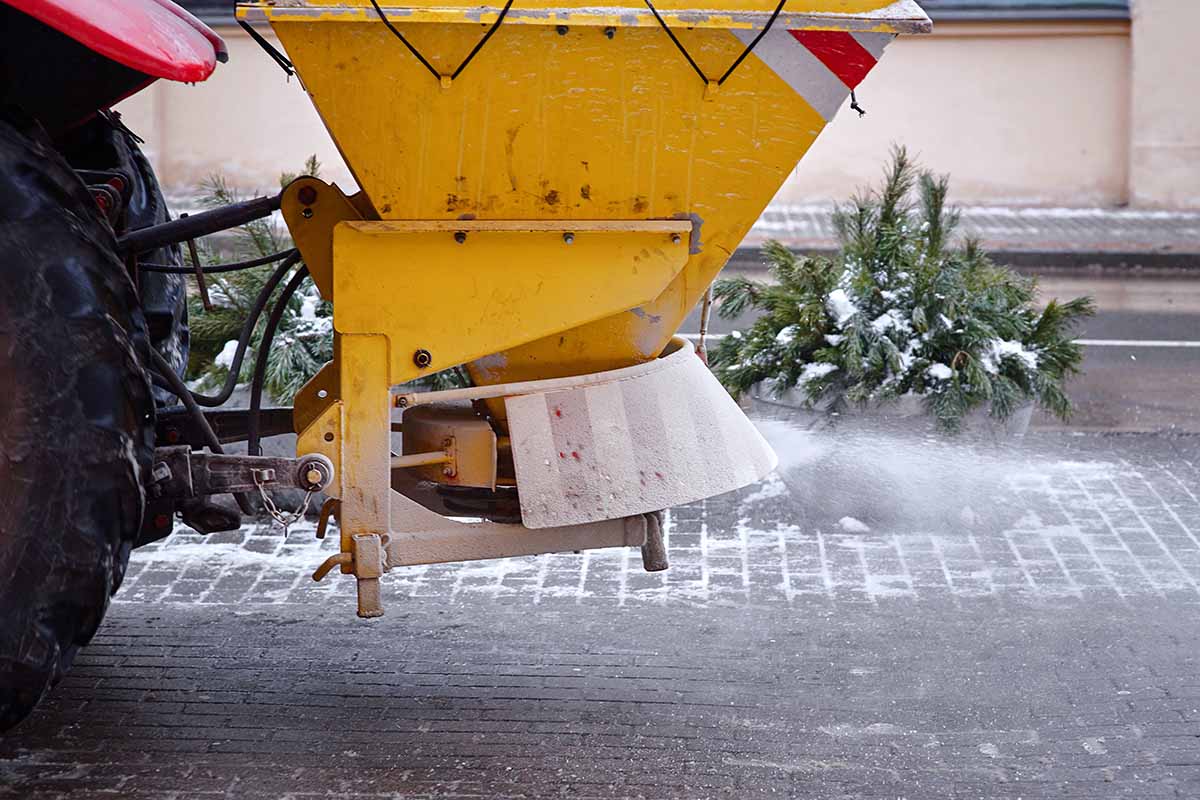

Group them in odd numbers, like three or five, and place taller specimens behind shorter ones for optimal visual appeal and light exposure.
Choose variegated foliage and bright blooms to bring the illusion of light to the darkest areas of the landscape and create eye-catching new focal points.
Neither salt nor shade are impediments when you install suitable plants in property perimeter, buffer zone, and coastal gardens.
Are you a shade gardener with salt issues to contend with? Please share your thoughts in the comments section below.
If you found this article informative and want to read about more types of plants that tolerate saline soil and/or low light, we recommend the following:
[ad_2]

